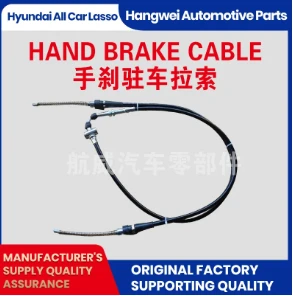Hydraulic Line for Clutch Slave Cylinder Performance and Maintenance Guide
Understanding the Role of the Clutch Slave Cylinder and Hydraulic Line in Automotive Systems
The clutch system is a vital component in the operation of manual transmission vehicles, allowing for the engagement and disengagement of the engine from the drivetrain. Among the crucial elements in this system are the clutch slave cylinder and the hydraulic line. Understanding their functions, interactions, and maintenance can significantly enhance vehicle performance and longevity.
What is a Clutch Slave Cylinder?
A clutch slave cylinder is a hydraulic device that plays a key role in the operation of the clutch. It is located on the transmission side of the clutch assembly and receives hydraulic pressure from the master cylinder, which is activated when the clutch pedal is depressed. This pressure is essential for the slave cylinder to move its piston, which in turn operates the release bearing or fork to disengage the clutch.
The Functioning of the Hydraulic System
The hydraulic system involved in the clutch operation works on the principle of incompressibility of liquids. When a driver presses the clutch pedal, the movement generates pressure within the master cylinder. This pressure travels through the hydraulic line to the slave cylinder. The hydraulic line, often made of flexible rubber or hard metal, ensures that the hydraulic fluid can move back and forth without leaks.
When the pressure reaches the slave cylinder, it forces the piston to move, disengaging the clutch. This process allows gear changes to be made smoothly without grinding the gears, enhancing both performance and driver comfort.
Signs of Malfunctions
While clutch slave cylinders and hydraulic lines are designed to be robust, they can sometimes fail due to wear and tear. Common symptoms of potential issues include
1. Difficulty in Engaging Gears If the slave cylinder is not functioning correctly, the driver may find it challenging to engage or disengage gears while driving. 2. Clutch Pedal Problems A soft or spongy clutch pedal may indicate air in the hydraulic line or a failing master/slave cylinder.
clutch slave cylinder hydraulic line

3. Fluid Leaks Inspecting the hydraulic lines for leaks can be essential. Fluid around the slave cylinder or along the hydraulic line indicates a potential failure that needs immediate attention.
4. Unusual Noises Grinding or rubbing noises may indicate that the clutch is not fully disengaging, often pointing to issues with the slave cylinder.
Maintenance and Care
To ensure the longevity and reliability of the clutch slave cylinder and the hydraulic line, regular maintenance is crucial. Here are some tips
- Regular Inspections Periodic checks of the hydraulic fluid levels and condition can prevent issues before they escalate. Ensure the fluid is clean and at the appropriate level.
- Bleed the System If air enters the hydraulic line, it can impede the clutch mechanism's function. Bleeding the system helps remove air and ensures a smooth operation.
- Inspect for Wear Check the hydraulic line for any signs of wear, cracks, or damage. Replace any worn components to avoid leaks and subsequent failure.
- Fluid Replacement Over time, hydraulic fluid can become contaminated. Regularly replacing it according to the manufacturer's recommendations can prevent corrosion and maintain system integrity.
Conclusion
The clutch slave cylinder and hydraulic line are integral to the efficient operation of a manual transmission vehicle. Understanding their functions helps drivers identify issues early on and ensures proper maintenance to prolong the life of their clutch system. By paying attention to signs of malfunction and adhering to regular maintenance schedules, vehicle owners can enjoy smoother gear shifts and enhanced driving experiences. Investing time in understanding this component of your vehicle is not just about repairs; it's about ensuring optimal performance and safety on the road.
-
Upgrade Your Control with Premium Throttle CablesNewsAug.08,2025
-
Stay in Control with Premium Hand Brake CablesNewsAug.08,2025
-
Experience Unmatched Performance with Our Clutch HosesNewsAug.08,2025
-
Ensure Safety and Reliability with Premium Handbrake CablesNewsAug.08,2025
-
Enhance Your Vehicle with High-Performance Clutch LinesNewsAug.08,2025
-
Elevate Your Ride with Premium Gear CablesNewsAug.08,2025
